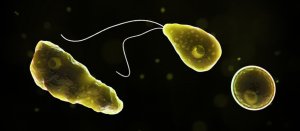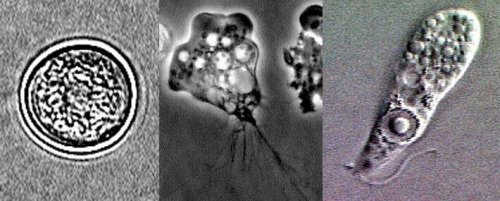Brain Eating Amoeba - Description and Causes

A couple of years ago, there was news about the brain-eating amoeba. In fact, some newscasts announced that several people contracted it and that some cases even led to death. But what are they about? How do they affect you?
Knowing a little more about this amoeba will give you an overview and you’ll know what you could be exposed to. The danger they represent demands an effort on society as a whole, especially in terms of prevention. In addition, the scope of action must be greater in those places where the threat is truly serious.
Similarly, reducing social alarm is one of the goals of this article. Thus, continue reading to learn a little more about the brain-eating amoeba.
The brain-eating amoeba
Its official name is Naegleria fowleri, and it belongs to the free-living protozoa due to its ability to survive and replicate in a given environment without a host. Fowler and Carter recorded the first case of primary amoebic meningoencephalitis (MAP) produced by this amoeba in 1965.
Fátima Petit’s team (2006) highlights that “they’re thermophilic amoebas that grow very well in tropical and subtropical climates”. One can find them mainly in warm and temperate water bodies, such as artificial lakes, lagoons, untreated pools, rivers, hot springs, and streams. Also, it breeds in pipes, water heaters, and water systems.

How does the brain-eating amoeba enter the human body?
The amoeba enters your body through the nose. When you dive or your nose comes into contact with contaminated water, the amoeba goes in and reaches your brain. The infection first happens at the level of the nasal mucosa and transfers to the olfactory nerve from there. Then, it goes through the sieve layer, where it reaches the olfactory bulbs of the central nervous system (CNS).
Once inside the CNS, it causes inflammation and leads to a release associated with cytotoxic agents that cause extensive tissue damage and necrosis. The destruction caused by this agent leads to the rupture of the membrane of the erythrocytes and the surrounding nerve cells.
The at-risk populations are usually children under 12 and the elderly. This is because children’s immune systems are still developing and, thus, they’re more vulnerable. In the case of older adults, their defenses are weaker and, therefore, more exposed to any possible damage that the amoeba could cause.
Symptoms
The incubation period ranges from two to eight days from the moment of infection. The most common symptoms are fever, chills, headache, photophobia, confusion, seizures, positive Brudzinski sign, positive Kerning sign, and even coma. These symptoms comprise a condition known as primary amoebic meningoencephalitis (MAP). Also, researchers detected cases of heart rhythm abnormalities and myocardial necrosis.
The mortality rate is usually 95% and it usually occurs between seven and 10 days after infection. Jacob Lorenzo, a parasitologist at the University of La Laguna, affirms it may happen faster.

Prevention and treatment
Prevention is still under development. It’s difficult to check for the presence of the brain-eating amoeba. However, the one thing researchers do know is that chlorinated water and salt water reduce its presence because it can’t survive in such environments. Thus, beaches and treated pools are safe for the most part.
A preventive measure is to avoid exposure to lakes, rivers, and ponds, especially during the summer months. In case you can’t avoid contact with these places, the recommendation is to avoid splashing or submerging your head underwater to keep amoeba from entering your body through your nostrils. Wearing nose clips may also help.
Prevention is important. This is why there are various water control measures set in place in order to prevent the proliferation of Naegleria fowleri. Another measure to deal with this amoeba is the investigation of new drugs to fight the infection and, also, new control systems to detect it as soon as possible.
When a person is infected by the brain-eating amoeba, the most common treatment to apply is amphotericin B. It’s an antibiotic, antifungal, antimicrobial, and antiparasitic. Drugs such as fluconazole, miconazole, miltefosine, azithromycin, and rifampicin are all in that category. Lorenzo Morales assures that the most important thing to do is to eradicate the amoeba. This is because a patient would die in a matter of days otherwise.
This text is provided for informational purposes only and does not replace consultation with a professional. If in doubt, consult your specialist.








